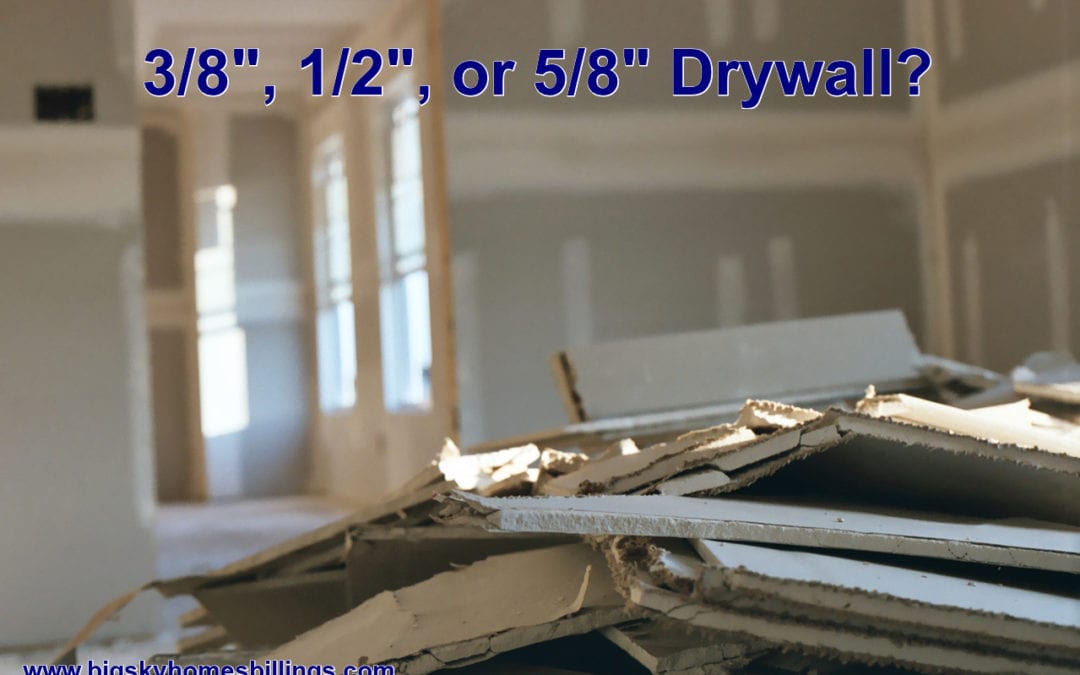Do You Know Why Drywall Comes in Different Thicknesses?
Economical and easy-to-install, drywall was introduced to the public in the 1940s as an alternative to plaster which was more expensive and took considerable time to be installed. Following several advancements in its production and application, drywall is now widely used and is a common inclusion in the construction of residential homes, as well as buildings for commercial business. Aside from its low cost, drywall is also very easy to customize. You can put wallpaper over it, paint it, or cover it with wood paneling. Big Sky Homes of Billings wants you to know all about the affordable house you are about to buy. So we put together an informational piece about drywall.

What is Drywall?
Also known as gypsum board, plasterboard, wallboard, or Sheetrock (which is actually a brand name), drywall consists of gypsum (calcium sulfate) on the inside, and paper facing both outer sides. Drywall is made by crushing gypsum into fine powder; drying the powdered material through a process called calcination; mixing the calcined gypsum with fiber, water, and other additives; pouring the mixture between layers of paper; then finally drying the mixture until it hardens and forms a solid mass. The finished product is a stiff, solid board that can be cut easily according to the required dimensions and measurements for constructing homes and buildings.
Available in different lengths and thicknesses, the most common types of drywall are 1/2 inch, 5/8 inch, and 3/8 inch. The thicker the drywall is, the stronger it is. Although, stronger doesn’t always necessarily mean better. Different thickness types are ideal for different requirements and locations.
1/2 inch Drywall
The most popular thickness type, 1/2 inch drywall, can be used for ceilings and walls. It is available in regular, fire-rated, and moisture-resistant varieties. Usually installed as a single layer over metal or wood framing that have spans of 16 inch or less, it can also be installed in two layers for added fire resistance and soundproofing properties. It is most commonly used because the thickness is just right, it can be manipulated more easily, and it generally blends in better with the architecture of the home or building it is used for. More importantly for many homeowners and do-it-yourself types, it is less expensive than the 5/8 inch type.
5/8 inch Drywall
Ideal for use in walls, ceilings, garages, and basements, 5/8 inch drywall has added fiber that gives it extra strength for ceilings (to avoid bending or sagging), helps it resist fire, and makes it effective for soundproofing. Unlike 1/2 inch drywall, 5/8 inch drywall can be installed in just a single layer and already provide adequate fire resistance and sound deadening properties. Additionally, the added thickness of ⅝ inch drywall makes it stiffer, less prone to denting, and capable of hiding frame imperfections. However, because it is heavier and costs a bit more, 5/8 inch is more often used when state or building code requires it for fire suppression purposes. Otherwise, you can still make do with 1/2 inch drywall, even for ceilings.
3/8 inch Drywall
Not as popular as the first two thickness types, 3/8 inch drywall has limited use, generally for interior enclosures only such as closets, pantries, or backing for paneling. Because it’s not as popular, the price for 3/8 inch is generally the same as 1/2 inch; the only reason to use it is for weight reduction.
Big Sky Homes Sells Up-to-Code Affordable Homes
Every house that we sell meets all of the current codes. You don’t have to worry about getting a house built with 1/2 inch drywall when 5/8 was needed.
If you are in the market for a home, but you are concerned about the high costs of traditionally built homes, then we have the solution for you! Come to Big Sky Homes and check out our lineup of manufactured homes. They are just as nice as any stick built house you can find on the market, and they cost considerably less.
See the map below for the location of Big Sky Homes at 750 Parkway Lane in Billings, Montana.


